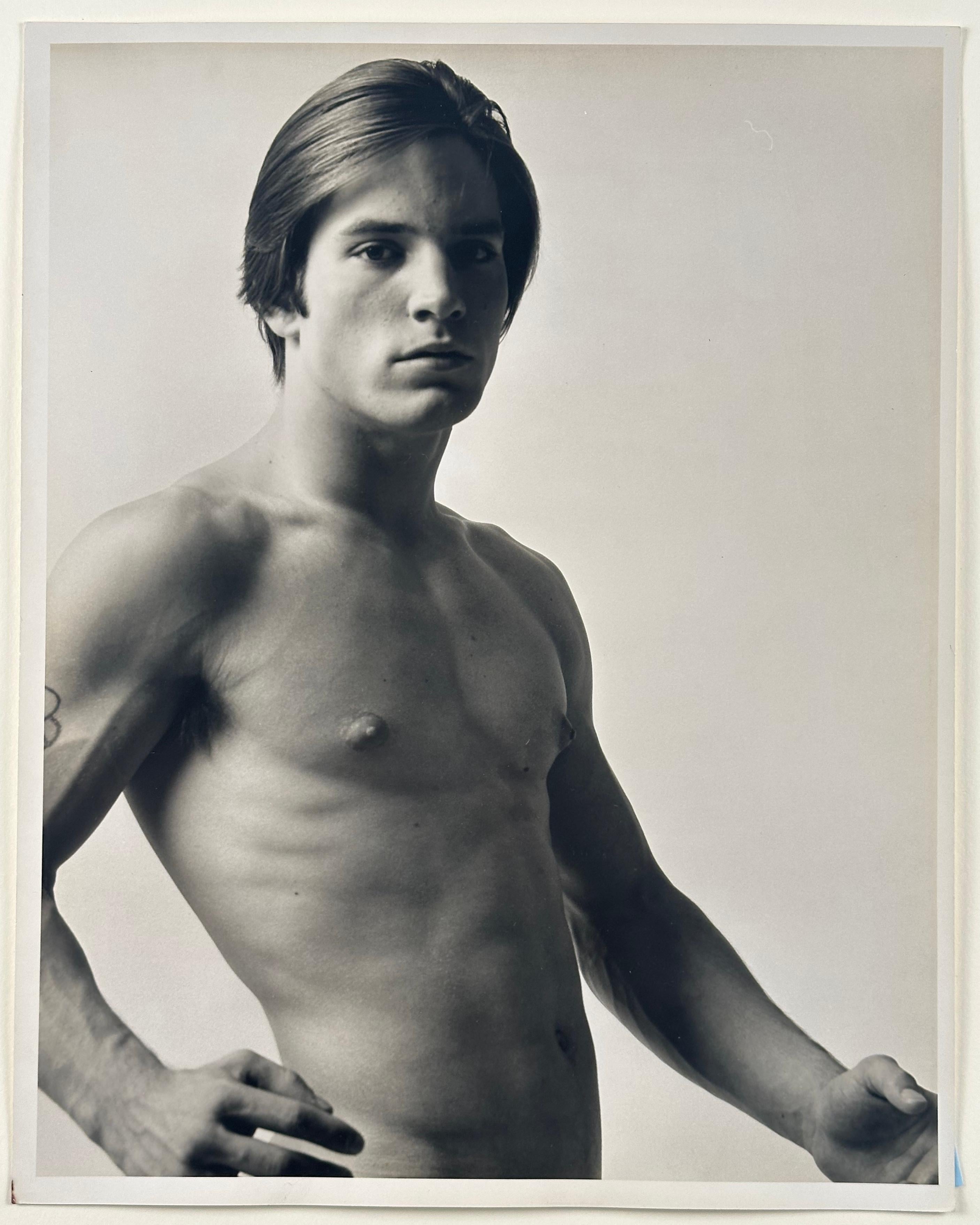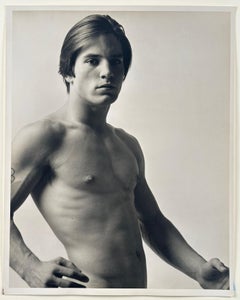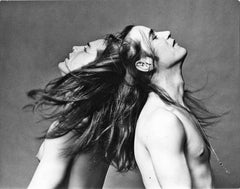Jack MitchellJoe Dallesandro Andy Warhol Trash promo photoca. 1970
ca. 1970
À propos de cet article
- Créateur:Jack Mitchell (1925 - 2013, Américain)
- Année de création:ca. 1970
- Dimensions:Hauteur : 35,56 cm (14 po)Largeur : 27,94 cm (11 po)Profondeur : 2,54 cm (1 po)
- Support:
- Mouvement et style:
- Période:
- État:
- Adresse de la galerie:Wilton Manors, FL
- Numéro de référence:1stDibs : LU245216483242
Jack Mitchell
Au cours de ses quatre décennies de carrière, le photographe Jack Mitchell a rendu compte de l'évolution du paysage culturel de l'Amérique du milieu et de la fin du XXe siècle en capturant les plus grands influenceurs et innovateurs des arts du spectacle et des arts visuels.
Mitchell, un maître de l'éclairage en photographie qui a publié son premier portrait à l'âge de 15 ans, a organisé plus de 5 400 séances photographiques au cours de sa vie, impliquant une liste de poseurs aussi étonnante que longue. Véritable liste de héros et d'idoles, les invités de son Studio sont des peintres, des danseurs, des acteurs, des comédiens, des chanteurs, des compositeurs, des réalisateurs, des écrivains, des imprésarios et tous ceux qui ont contribué à façonner l'air du temps.
Pendant la Seconde Guerre mondiale, alors qu'il n'avait que 16 ans, Mitchell a photographié Veronica Lake pour un journal de Daytona. Il s'agissait de son premier contrat avec une célébrité, mais cela n'a pas empêché l'audacieux jeune homme de demander à l'actrice de rabattre ses mèches "peekaboo" pour qu'il puisse avoir son visage entier dans le cadre. Lake, qui se trouvait en Floride pour participer à l'effort de guerre et qui était au sommet de sa carrière, a poliment accepté, et les deux sont devenus des amis de longue date.
Mitchell, qui était ouvertement gay (son partenaire et manager de longue date, Robert Plavik, est décédé en 2009), a également noué une relation étroite avec Gloria Swanson. De 1960 à 1970, il a été son paparazzo personnel, prenant diverses photos "candides" de l'actrice vieillissante mais éternellement glamour, comme si elle était une star de la téléréalité d'avant la téléphonie mobile et d'avant les médias sociaux.
Les diverses publications dans lesquelles le travail de Mitchell a été publié - outre le New York Times, il y a Rolling Stone, Dance Magazine, People, Vogue, Vanity Fair, Time, Harper's Bazaar et Newsweek - témoignent de la puissance de son langage visuel saisissant et de sa capacité à transcender les thèmes et les disciplines.
Mitchell a également réalisé une série de portraits intimes de John Lennon et Yoko Ono en novembre 1980, un mois avant l'assassinat du chanteur des Beatles. Une photo de cette séance a fait la couverture du numéro commémoratif de People, l'une des éditions les plus vendues du magazine à ce jour.
L'éclat du showbiz ne doit pas faire oublier l'approche méticuleuse de Mitchell à l'égard de la photographie . Il tenait à produire ses propres tirages afin d'obtenir ce qu'il considérait comme une patine et une définition de qualité muséale.
"Jack a tiré de nombreux rouleaux de pellicule noir et blanc, et toujours quelques transparents couleur, de chaque personne célèbre qu'il a photographiée", explique Craig Highberger, un ami du défunt photographe et le directeur exécutif du site Jack Mitchell Archives.
Dans le monde de la danse, domaine pour lequel Mitchell est le plus connu, ses clichés saisissants et incisifs d'interprètes et de chorégraphes légendaires reflètent l'énergie viscérale que ces sommités ont insufflée à la discipline dans les années 1960 et 1970, largement considérées comme l'âge d'or de la danse théâtrale américaine.
"Les photographies de danseurs prises par Jack au cours de sa vie constituent une chronique historique d'une période extraordinaire de l'histoire de la danse. Il a été le photographe de la compagnie de danse d'Alvin Ailey de 1961 à 1994", explique M. Highberger, qui précise que la collection de 10 000 tirages noir et blanc d'Ailey appartenant à M. Mitchell se trouve aujourd'hui au Musée national de l'histoire et de la culture afro-américaines du Smithsonian.
Les images de danse de Mitchell sont à la fois éthérées et puissamment dynamiques. Non seulement ils évoquent le mouvement par des poses élégantes et une tension musculaire disciplinée, mais ils transmettent également une énergie intime émanant directement de ses sujets, comme s'il avait magiquement déverrouillé une humeur réfléchie ou un trait de caractère, sans artifice.
La collection de photographies authentiques de Jack Mitchell sur 1stDibs comprend ses photographies en noir et blanc, photographies en couleur, photographies de nus et bien plus encore.
- ExpéditionRecherche du devis...Expédition depuis : Wilton Manors, FL
- Politique des retours
Plus d'articles de ce vendeur
Tout afficherannées 1970, Photoréalisme, Photographie noir et blanc
Papier photo
années 1970, Photoréalisme, Photographie noir et blanc
Papier photo
années 1970, Réalisme américain, Photographie noir et blanc
Tirage argentique
années 1970, Photoréalisme, Photographie noir et blanc
Papier photo
années 1970, Réalisme américain, Photographie noir et blanc
Tirage argentique
années 1970, Surréalisme, Photographie noir et blanc
Papier photo
Suggestions
années 1970, Pop Art, Photographie noir et blanc
Tirage argentique
années 1970, Pop Art, Photographie noir et blanc
Tirage argentique
Jack MitchellWarhol Superstar Joe Dallesandro, pose emblématique «ough trade » pour After Dark, 1970
années 1970, Pop Art, Photographie noir et blanc
Tirage argentique
années 1970, Pop Art, Photographie noir et blanc
Tirage argentique
années 1970, Pop Art, Photographie noir et blanc
Tirage argentique
années 1960, Pop Art, Photographie noir et blanc
Tirage argentique


